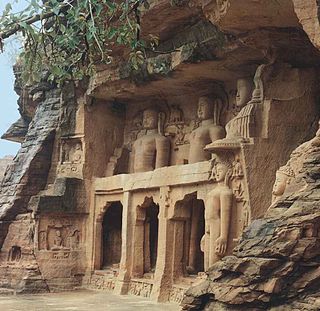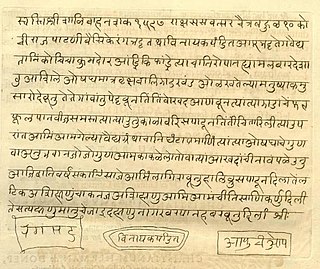Related Research Articles

Vikram Ambalal Sarabhai was an Indian physicist and astronomer who initiated space research and helped develop nuclear power in India. He was honoured with Padma Bhushan in 1966 and the Padma Vibhushan (posthumously) in 1972. He is internationally regarded as the Father of the Indian Space Program

Mehsana, also spelled Mahesana, is a city and municipality in Mehsana district, in the Indian state of Gujarat. Established in 14th century, the city was under Gaekwads of Baroda State from 18th century to the independence of India in 1947. The municipality was established in 1919–20. The town has population of about 185,000. Dairy, oil and natural gas are major industries while there are several small and medium enterprises in the city.
Vikram Samvat, abbreviated V.S. and B.S. )

Mehsana district is one of the 33 districts of Gujarat state in western India. Mehsana city is the administrative headquarters of this district. The district has a population of over 1.8 million and an area of over 4,500 km². There are over 600 villages in this district with a population of 2,035,064 of which 22.40% were urban as of 2011.
The Vira Nirvana Samvat (era) is a calendar era beginning on 15 October 527 BCE. It commemorates the Nirvana of Lord Mahaviraswami, the 24th Jain Tirthankara. This is one of the oldest system of chronological reckoning which is still used in India.

The Nagavanshi were rulers from the Indian subcontinent, in the area of present-day Indian states of Madhya Pradesh, Chhattisgarh, Jharkhand and Odisha. Nagavanshi is a house of warriors claiming descendancy from Nagas. The Nagas were mentioned as an snake-worshipping tribe of ancient India.

The Filmfare Best Actor Award is given by the Filmfare as part of its annual Filmfare Awards South for Tamil film lead actors. The Filmfare Awards South Awards were extended to "Best Actor" in 1972. The year indicates the year of release of the film.
There are numerous days throughout the year celebrated as New Year's Day in the different regions of India. Observance is determined by whether the lunar calendar is being following or the solar calendar. Those regions which follow the Solar calendar, the new year falls on Sankranti of the first month of the calendar, i.e., Vaishakha. Generally, this day falls during 14th or 15th of the month of April. Those following Lunar calendar consider the month of Chaitra as the first month of the year, so the new year is celebrated on the first day of this month. Similarly, few regions in India consider the period between consecutive Sankarantis as one month and few others take the period between consecutive Purnimas as a month.

Kashtha Sangha was a Digambar Jain monastic order once dominant in several regions of North and Western India. It is considered to be a branch of Mula Sangh itself. It is said to have originated from a town named Kashtha.
Gahoi is a merchant community in central India.

Acharya Vijay Vallabhsuri was a Jain monk. He was a disciple of Vijayanandsuri. He worked for the religious as well as improving the social life of people. He worked in Punjab so he was given honorific Punjab Kesari.
The Kutila inscription of Bareilly is an inscription in the Kutila script dating to 992 CE that provides crucial evidence in tracing the shared descent of the Devanagari and Bengali-Assamese scripts of Northern and Eastern India from the predecessor Gupta script. The writing was found on a stone unearthed in Bareilly district in the United Provinces of Agra and Oudh. The inscription proclaims that it was created by an engraver from Kannauj who was "proficient in the Kutila character". It also includes the date of the inscription, Vikram Samvat 1049, which corresponds to 992 CE.
Kharwar is a community found in the Indian states of Uttar Pradesh, Bihar, Jharkhand, Chhattisgarh, Orissa and West Bengal.

Nāgar Barap is an abugida alphabet of India. It was the predecessor of the Devanagari script It is written from left to right, does not have distinct letter cases, and is recognizable by a horizontal line that runs along the top of full letters.

Aharji is a historical pilgrimage site for Jainism in India. It is located in the central Indian state of Madhya Pradesh, on the road from Tikamgarh to Chhatarpur. This place is famous for Jain Temple.

Panyas Chandrashekhar Vijayji Maharaj Saheb, also known as Gurudev or Guruma, was a Jain monk, scholar and author. Born and educated in Mumbai, he was initiated as a monk who later designated Panyas. He was involved in religious as well as sociopolitical activities. He founded several institutions and authored 261 books.

Nepali is an Indo-Aryan language of the sub-branch of Eastern Pahari. It is the official language of Nepal and one of the 22 scheduled languages of India. Also known by the endonym Khas kura, the language is also called Gorkhali or Parbatiya in some contexts. It is spoken mainly in Nepal and by about a quarter of the population in Bhutan. In India, Nepali has official status in the state of Sikkim, and significant number of speakers in the states of Arunachal Pradesh, Assam, Himachal Pradesh, Manipur, Mizoram, Uttarakhand and West Bengal's Darjeeling district and Kalimpong. It is also spoken in Myanmar and by the Nepali diaspora worldwide. Nepali developed in proximity to a number of Indo-Aryan languages, most notably the other Pahari languages and Maithili, and shows Sanskrit influence. However, owing to Nepal's location, it has also been influenced by Tibeto-Burman languages. Nepali is mainly differentiated from Central Pahari, both in grammar and vocabulary, by Tibeto-Burman idioms owing to close contact with this language group.

Mahudi Jain Temple is situated in Mahudi town in Mansa taluka of Gandhinagar district, Gujarat. It is a pilgrimage centre of Jains and other communities visiting temple of Jain deity, Ghantakarna Mahavir and Padmaprabhu Jain Temple. It was known as Madhupuri historically.
Shivdas Karn was Nagvanshi king in 14th century. He succeeded Go Karn.
The Khayaravala dynasty, was a dynasty, that ruled parts of the present-day Indian states of Bihar and Jharkhand, during 11th and 12th centuries. Their capital was located at Khayaragarh in Shahabad district. Pratapdhavala and Shri Pratapa were king of the dynasty according to inscription of Rohtas. The dynasty ruled the Japila territory(now Japla) as feudatories, of the Gahadavalas.
References
- ↑ Majestic Monuments of India: Ancient Indian Mega Structures. books.google.co.in. Retrieved 22 December 2019.
- ↑ bonded Histories: Genealogies of Labor Servitude in Colonial Indiaq. books.google.co.in. Retrieved 22 December 2019.
- ↑ Jharkhand Samanya Gyan. books.google.co.in. Retrieved 22 December 2019.
- ↑ "THE KHAYARAVĀLA DYNASTY". jstor.org. Retrieved 22 December 2019.